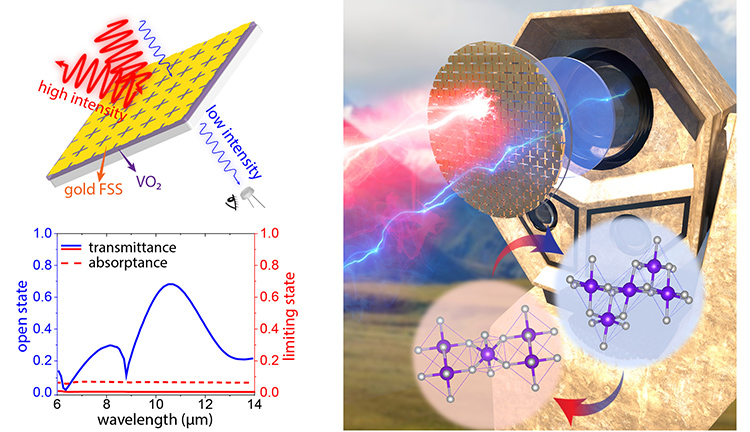 Left top: A schematic of the vanadium oxide reflective optical limiter. Left bottom: Transmittance and absorptance spectra of the optimized optical limiter design. Right: An artist’s view of the vanadium oxide reflective optical limiter. [Image by X. Zou and C. Wan]
Left top: A schematic of the vanadium oxide reflective optical limiter. Left bottom: Transmittance and absorptance spectra of the optimized optical limiter design. Right: An artist’s view of the vanadium oxide reflective optical limiter. [Image by X. Zou and C. Wan]
Optical limiters are nonlinear devices that feature decreasing transmittance with increasing incident optical intensity, and thus can protect sensitive optical components from high-intensity illumination. Most existing optical limiters operate based on nonlinear absorption—that is, they begin absorbing light when the incident power reaches a certain threshold. However, this mode of operation is suboptimal because absorption of high-power light can result in damage to the optical limiter itself.
Recently, there have been some attempts to make optical limiters that reflect rather than absorb light. However, these attempts have fallen short in terms of operational bandwidth and/or volatility—that is, the ability to passively recover to a transparent state after the limiter is triggered. Therefore, we were motivated to design and demonstrate an ultrathin, broadband reflective optical limiter.1
We designed our reflective optical limiter using vanadium dioxide (VO2) as the nonlinear medium, incorporated into a metal-based frequency selective surface (FSS). In the transparent (open) state, light is able to resonantly tunnel through the resonance of the FSS. However, upon high-power incidence, the VO2 undergoes an insulator-to-metal phase transition, resulting in a large change in its complex refractive index,2 removing the resonant tunneling mechanism, and resulting in an opaque (limiting) state.
The optimized design of our optical limiter features a broad transmission band in the open state and essentially zero transmittance in the limiting state, accompanied by a minimized absorptance, indicating a high damage threshold against high-power illumination. Our design is broadly scalable across wavelengths in the mid and far infrared.
Researchers
Chenghao Wan, Jad Salman, Jonathan King, Yuzhe Xiao, Zhaoning Yu, Alireza Shahsafi, Raymond Wambold and Mikhail A. Kats, University of Wisconsin-Madison, Madison, WI, USA
Zhen Zhang and Shriram Ramanathan, Purdue University, West Lafayette, IN, USA
References
1. Wan C. et al. Laser Photon. Rev. 15, 2100001 (2021).
2. Wan C. et al. Ann. Phys. 531, 1900188 (2019).
